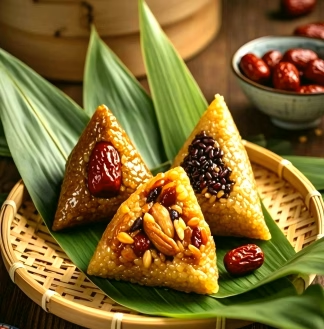Have you ever encountered problems like steamed zongzi sticking to the leaves, radish cakes being too mushy, uneven layers in nine-layer churn, overflowing rice balls, cracked glutinous rice balls, insufficient water content in the rice paste, and exposed filling in dumplings?
Whether it’s rice-based dishes like bowl cakes, meat dumplings, or pearl meatballs, or pasta-based dishes like steamed buns, dumplings, scallion pancakes, or pan-fried buns, they all offer a comforting and delightful treat.
Experts will explain the unspoken pitfalls of making zongzi, effectively solving cooking problems and mastering delicious recipes:
Q1: My steamed zongzi stick to the leaves and don’t form perfectly. What’s wrong?
A: The main issue is that the leaves aren’t moist enough. Therefore, it’s crucial to ensure they’re sufficiently moist before wrapping. Before wrapping the zongzi, be sure to boil or soak them to allow them to absorb sufficient moisture.
Additionally, if you mix the glutinous rice with some oil before wrapping, you can prevent it from sticking to the leaves.
Q2 Why does radish cake become too mushy?
A: When making radish cake, the ratio of rice flour to water is usually around 1:1 or 1:2, with some variation. This is because the water content of radish is variable. If the water content is higher, less water is needed.
After stir-frying the radish, mix it with the rice paste and cook until it is gelatinized. The paste should not be too thick to prevent starch precipitation, which will affect the appearance and texture of the steamed bun.
Q3 Why are the layers of the nine-layer churn uneven?
A: The distinct layers of the nine-layer churn not only look beautiful but also have a dense and soft texture. However, because each layer must be dense and cohesive, the batter must be poured in at a consistent thickness. The cookedness must also be consistent before adding the next layer.
If any step in this process is not done properly, the layers and appearance of the bun will be affected after it is cut. In addition, the heat and cooking time must be properly controlled.
Q4 Why do the fillings in five-color rice crackers burst, and how can this be avoided?
A: To achieve crispy exteriors, tender interiors, and a well-maintained shape, fry the five-color rice crackers at a lower temperature for a short time to set the shape, allowing the heat to gradually penetrate the ingredients.
Remove the ingredients, raise the oil temperature, and then re-fry them. When the ingredients are surrounded by the high-temperature oil, the surface quickly absorbs the heat, causing moisture to evaporate. This creates the perfect result: a crispy exterior, tender interior, and a flawless filling.
Q5 How can I cook glutinous rice balls with fermented glutinous rice wine without breaking?
A: To avoid breaking, first ensure there is enough water. This prevents the glutinous rice balls from sticking to each other and breaking. Once the water is boiling, lower the heat before adding the glutinous rice balls. Using a spatula can also help prevent the glutinous rice balls from breaking.
Q6 How should I control the amount of water when making the rice batter?
A: The firmness of rice paste depends on the amount of water added. Adding more water will create a paste-like texture, resulting in a softer texture. Adding less water will create a clumpy, firmer texture.
However, since different types of rice paste require different water contents, they must be mixed thoroughly to avoid unmixed flour that could lead to failure.
The rice paste must be thoroughly stirred during the initial heating process, and high heat should not be used. Instead, heat over low heat, adjusting the degree of gelatinization based on the desired final product. Failure to stir during heating can easily cause the bottom to burn.
Q7: Why do salty dumplings crack during cooking? Why does the filling leak out during frying?
Overfilling can easily cause the skin to crack.
Frying at high temperatures throughout the entire process increases the chance of the filling bursting.
Excessive oil temperature can easily cause the filling to burst.
Failure to pinch the edges tightly can easily cause cracks.
A: Boil some of the kueh dough in boiling water before adding the raw kueh dough and kneading it. This not only creates a chewy kueh wrapper but also makes it easier to wrap. Don’t overfill the filling; if you overfill, the wrapper may break before it’s even cooked.
Furthermore, the oil temperature is crucial for deep-frying salty dumplings to achieve a crispy, golden exterior and a more flavorful filling. Therefore, it’s crucial to control the temperature; it shouldn’t be too high. Start by frying in warm oil.
Let the interior cook through, then increase the oil temperature to achieve a crispier exterior. If the oil temperature is too high throughout the cooking process, the filling may burst or become undercooked.


Leave a Reply